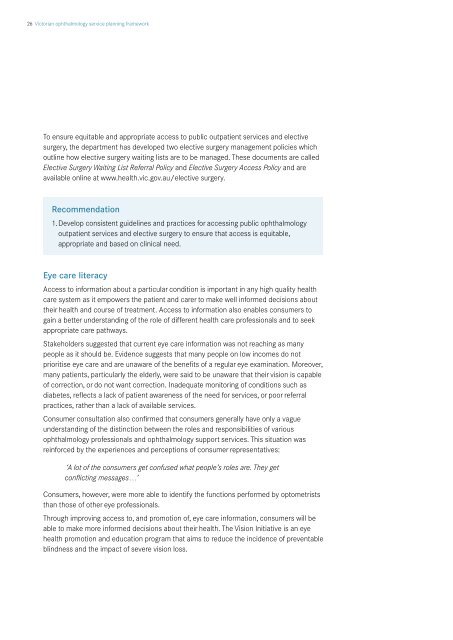Victorian ophthalmology service planning framework
Victorian ophthalmology service planning framework
Victorian ophthalmology service planning framework
Create successful ePaper yourself
Turn your PDF publications into a flip-book with our unique Google optimized e-Paper software.
26 <strong>Victorian</strong> <strong>ophthalmology</strong> <strong>service</strong> <strong>planning</strong> <strong>framework</strong><br />
To ensure equitable and appropriate access to public outpatient <strong>service</strong>s and elective<br />
surgery, the department has developed two elective surgery management policies which<br />
outline how elective surgery waiting lists are to be managed. These documents are called<br />
Elective Surgery Waiting List Referral Policy and Elective Surgery Access Policy and are<br />
available online at www.health.vic.gov.au/elective surgery.<br />
Recommendation<br />
1. Develop consistent guidelines and practices for accessing public <strong>ophthalmology</strong><br />
outpatient <strong>service</strong>s and elective surgery to ensure that access is equitable,<br />
appropriate and based on clinical need.<br />
Eye care literacy<br />
Access to information about a particular condition is important in any high quality health<br />
care system as it empowers the patient and carer to make well informed decisions about<br />
their health and course of treatment. Access to information also enables consumers to<br />
gain a better understanding of the role of different health care professionals and to seek<br />
appropriate care pathways.<br />
Stakeholders suggested that current eye care information was not reaching as many<br />
people as it should be. Evidence suggests that many people on low incomes do not<br />
prioritise eye care and are unaware of the benefits of a regular eye examination. Moreover,<br />
many patients, particularly the elderly, were said to be unaware that their vision is capable<br />
of correction, or do not want correction. Inadequate monitoring of conditions such as<br />
diabetes, reflects a lack of patient awareness of the need for <strong>service</strong>s, or poor referral<br />
practices, rather than a lack of available <strong>service</strong>s.<br />
Consumer consultation also confirmed that consumers generally have only a vague<br />
understanding of the distinction between the roles and responsibilities of various<br />
<strong>ophthalmology</strong> professionals and <strong>ophthalmology</strong> support <strong>service</strong>s. This situation was<br />
reinforced by the experiences and perceptions of consumer representatives:<br />
‘A lot of the consumers get confused what people’s roles are. They get<br />
conflicting messages…’<br />
Consumers, however, were more able to identify the functions performed by optometrists<br />
than those of other eye professionals.<br />
Through improving access to, and promotion of, eye care information, consumers will be<br />
able to make more informed decisions about their health. The Vision Initiative is an eye<br />
health promotion and education program that aims to reduce the incidence of preventable<br />
blindness and the impact of severe vision loss.

















